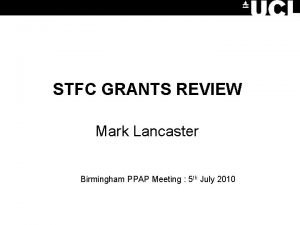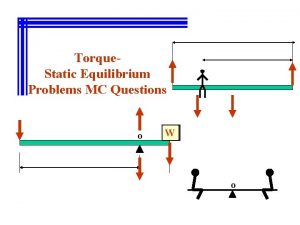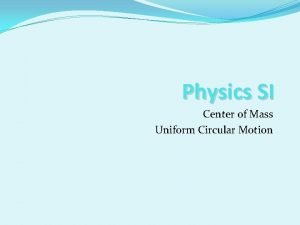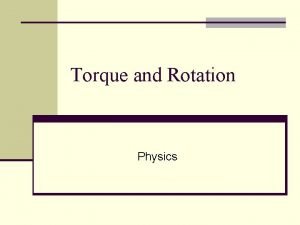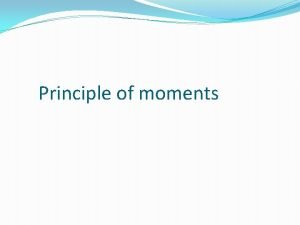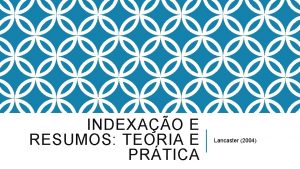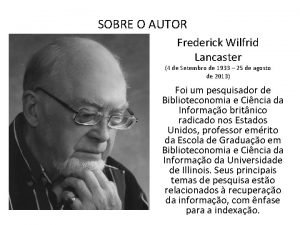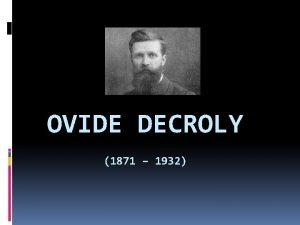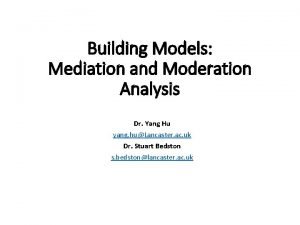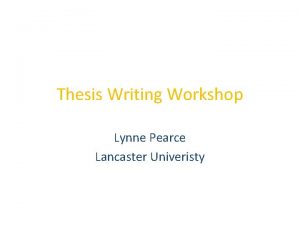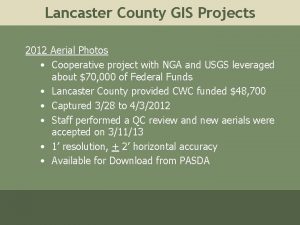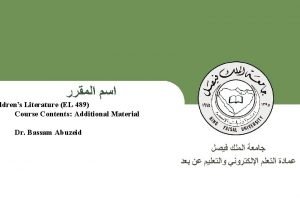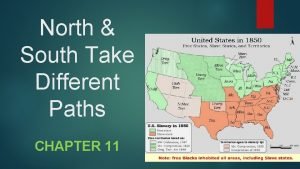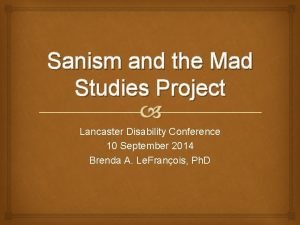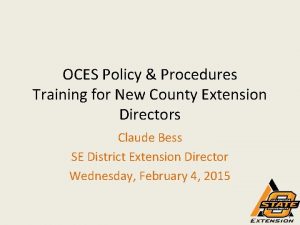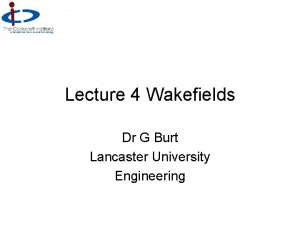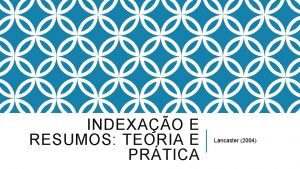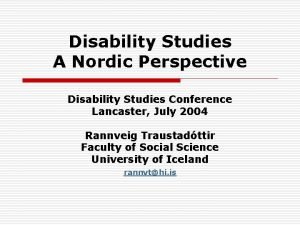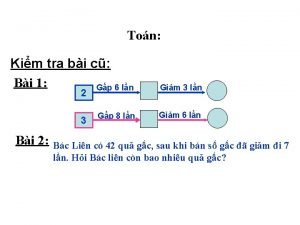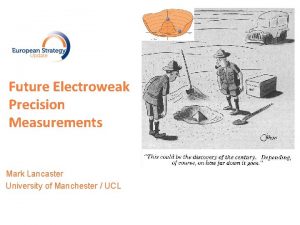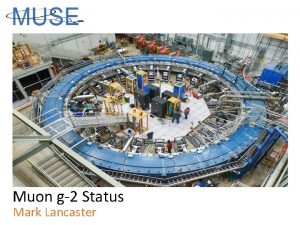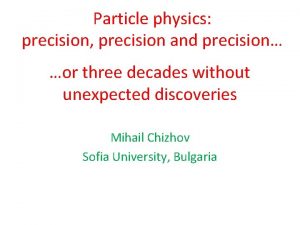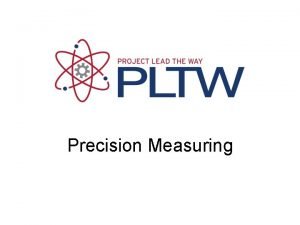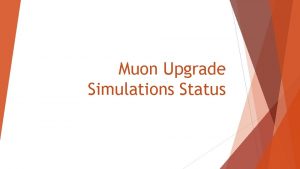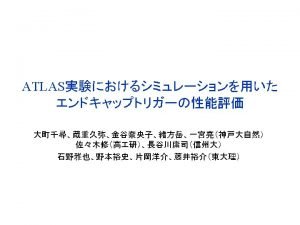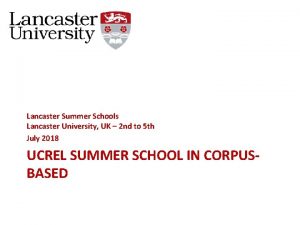Precision Muon Experiments Mark Lancaster Motivation SEESAW MECHANISM













































- Slides: 45

Precision Muon Experiments Mark Lancaster

Motivation SEESAW MECHANISM 100 Ge. V-GUT SCALE HEAVY MAJORANA ν LIGHT ν Decay LEPTON ASYMMETRY Sphaleron 0νββ EXPERIMENTS CHARGED LEPTON-FLAVOUR VIOLATION EXPTS Interactions BARYON ASYMMETRY ν OSCILLATION EXPTS

Motivation Precision studies of the lepton sector provide insights on new physics to complement LHC and in general are probing physics at a higher scale. The phenomenology of the universe’s matter anti-matter asymmetry will not be understood without neutrino AND charged lepton violation measurements. 17 of the top 25 hep-ex most cited papers for 2010 are in the neutrino and c. LFV area

Why Muons ? Present tau limits are at O(10 -8) and Super-B O(10 -9). Model dependent but O(10 -9) in τ has similar sensitivity as O(10 -12) in μ and this muon sensitivity will be achieved in the next year or so. Advances in accelerator/solenoid technology & detectors will increase sensitivity limits by factor of 100 by 2013 (μ eγ) & 105 (μN e. N) in O(5) years in muon flavour violation. SUSY See. Saw

Muons vs Taus

Why Muons ? In most of the muon measurements we have the situation where the SM rate/value is essentially zero e. g. BR(μ eγ) is 10 -53 in SM such that any observation is new physics or …. a systematic error. . SINDRUM-2 SEARCH FOR c. LFV μN-e. N

SM is in relatively good shape for muon predictions e. g. Recent improvement by factor of 10 in muon lifetime and hence G F 2. 5 σ below previous PDG MULAN (@ PSI) : 1012 muons PRL. 106, 041803 (2011) GF now know to 1 ppm Theory ~ 0. 2 pppm

Measurement Ongoing/Planned Two classes of measurement Deviation from precisely known SM value Magnetic Dipole Moment / “g-2” ~ 0. 002 but predicted in SM to 0. 42 ppm Present experimental uncertainty : Δ(aμ) = 63 x 10 -11 (0. 54 ppm) Measure non zero value where SM value ~ 0 Electric Dipole Moment / EDM : present limit (10 -19 ) is poor compared to other EDMs. SM value ~ 10 -36 Lepton flavour violating interactions. Present limits 10 -11 -12. SM ~ 10 -50 All taking place at PSI, J-PARC/Osaka, FNAL

Muon Dipole Moments aμ = ½ (g-2) : has SM (strong, weak, EM) contribution + BSM. η = 0 : any deviation from this is new physics (CP-violating) Muon dipole moments (cf neutron) are single-particle and so potentially “cleaner” probes of any BSM physics. e. EDM molecular corrections

g-2 / aμ (Magnetic) Latest result from BNL E-821 (data 2001, published 2004) All recent developments have been largely in theory prediction : new techniques & new input low-E e+e- / γγ data.

g-2 / aμ : BNL result Long-standing discrepancy wrt SM prediction

g-2 / aμ : BNL result Needs progress on both theory and experiment to establish 5σ significance

g-2 / aμ : Theory developments/plans Time Several recent workshops in light of new experimental proposals With better computing power availability renewed emphasis on lattice calculations

g-2 / aμ : Comparison to Snowmass SUSY points aμ offers complementary test of BSM to LHC and could potentially help resolve BSM model degeneracies

g-2 / aμ : Two future experimental proposals Traditional approach : use magic p = 3. 09 Ge. V muons. - BNL measurement and proposed FNAL 989 measurement Use smaller storage ring with higher (more uniform) B with E=0 & ultra-cold muons - J-PARC measurement

g-2 / aμ : FNAL Proposal (E 989) Move existing BNL ring to FNAL and utilise higher intensity FNAL p-beam and 900 m π decay line Aiming for x 4 improvement in aμ uncertainty to be 0. 1 ppm (16 x 10 -11) measurement Expecting theory uncertainty to reduce from 49 x 10 -11 to 30 x 10 -11 such that present ~ 3. 5 σ discrepancy would become ~ 7. 5σ

FNAL g-2 (E 989) Run in parallel with NOVA : requires 4 x 1020 POT : comfortably attainable from 2 yrs running ~ 2015 -2017. Can share beam with NOVA/Micro. Boone but not with mu 2 e. Estimate 2 week turn around to switch between mu 2 e and (g-2) configuration Nominally $40 M project (with contingency). Some costs shared with mu 2 e. CD-1 approval granted in January 2011 and construction begins 2012.



Alternative technique : ultra-cold muons No vertical focussing E-field and larger (and uniform) B-field using MRI advances Requires v. small vertical beam divergence : Δp. T/p. T = 10 -5 Requires advances in “muonium” production - target materials e. g. nano-structured Si. O 2 - lasers (pulsed 100 μJ VUV) to ionise muonium (x 100) Techniques being pursued at PSI for EDM measurement and JPARC for g-2

JPARC g-2

JPARC g-2 Muons from 2100 K to 300 K Active R&D at TRIUMF (different target materials) and RAL/RIKEN An area of fruitful cross-disciplinary collaboration both within HEP e. g. Si. LC readout, BELLE sensors and outside : material scientists, laser chemists etc

JPARC g-2 BNL E 821/ FNAL E 989 J-PARC Clearly Pros and Cons of two approaches: Cold muons : no pion contamination, no coherent betatron oscillations BUT : π+ only and as yet unproven method “Hot” muons : proven technology, utilising existing accelerator etc

Muon EDM Ed. Hinds e. EDM 10 -11 eγ Predicted EDM assuming same New Physics gives the present anomalous g-2 10 -13 eγ “Expect” muon EDM of 10 -22 or CP violating phase is strongly suppressed.

Muon EDM from parasitic g-2 running

Parasitic Measurements concurrent with g-2 (g-2) signal: # Tracks vs time, modulo g-2 period, in phase. 10 -22 EDM Signal: Average vertical angle modulo g-2 period. 900 degree out-offrom g-2 BNL achieved : 1. 8 x 10 -19 FNAL E 989 should get to 10 -21

Require measurements below 10 -21 BNL measurement FNAL E 989 parasitic g-2 (2017) JPARC parasitic g-2 (2017) Dedicated Project-X measurement Dedicated JPARC measurement

EDM Below 10 -21 : Frozen Spin Parasitic EDM has intrinsic limitation at ~ 10 -21 To go below this : use so-called “Frozen Spin” technique - judicious E and B to cancel magnetic moment contribution

PSI “Frozen Spin” EDM Proposal PSI proposal (hep-ex/0606034 v 3) (g-2) signal: # Tracks vs time, modulo g-2 period, in phase.

PSI EDM Proposal PSI is proof-of-principle experiment for the “frozen spin” technique. Low momentum (p=125 Me. V) and relatively high B-field (1 T) Needs new injection scheme e. g. 3 ns ILC kicker or resonant injection & sacrifice beam Intensity for beam quality Both JPARC & FNAL have proposals (timescale ~ 2020) to improve this by x 50 to 10 -24

CHARGED LEPTON FLAVOUR VIOLATION LFV observed in neutrino sector and in SM predicted to be O(10 -50) in charged sector In SM extensions : 10 -10 to 10 -20 level Compared to g-2 / EDMs c. LFV tends to have sensitivity beyond EWK scale

MEG Experiment So far 3 physics runs : 2008, 2009, 2010 and now taking data in 2011

MEG Experiment Preliminary analysis of 2009 data (July 2010) Limit < 1. 5 x 10 -11 @ 90% CL Final 2009 analysis + 2010 data released for ICHEP-2011 : expected limit < 1. 5 x 10 -12 2011 data should get to the intrinsic sensitivity of eγ of 10 -13

c. LFV beyond 10 -13 Only candidate is coherent muon to electron transition in muonic atom Two proposals: - COMET (J-PARC) - Mu 2 e (FNAL) With similar timelines (“funding” + 5 ~ 2017), cost ($150 M) and sensitivity.

c. LFV beyond 10 -13 O(10 -13 -15) in μN-e. N is required to have similar sensitivity as MEG limit of 10 -13 in eγ COMET / mu 2 e are aiming for sensitivity of 10 -16 with upgrade options to go to 10 -18 Factor of ~ 10, 000 improvement on previous (SINDRUM-II) limit of 6 x 10 -13

Muon to Electron Conversion - Pulsed proton beam to reduce prompt backgrounds. - Measure signal after O(700 ns) delay to reduce standard muon background - Radiation tolerant superconducting solenoids - Improve low momentum backward pion yield around target - Momentum select low momentum pions/muons - Momentum select high energy (105 Me. V) electrons - High resolution/occupancy straw trackers - High resolution 100 Me. V electron calorimetry

COMET Experiment

Mu 2 e Experiment

COMET Experiment ~ 60 people from Japan, Canada, Russia, Vietnam, Malaysia, UK UK : UCL, Imperial.

Experiment Status Both experiments at a similar stage: - COMET received stage-1 of 2 stages of approval from KEK PAC in 2009 based on a CDR. Expecting to submit TDR at end of the year. - mu 2 e has CD 0 in FNAL and similarly is bidding for CD-1 approval before end of year Detector design and some aspects of the simulation are more mature in mu 2 e. Aspects of the accelerator/solenoid design more mature in COMET - COMET has prototype pion production environment (MUSIC @ OSAKA) Formal collaboration between the two experiments at KEK-FNAL level – particularly in area of radiation tolerance of superconducting solenoids. It’s certainly an area (cf Dark Matter) where independent verification of a signal across 2 experiments would be welcome.

Proton Extinction / Magnet Irradiation Require absence of spill-over protons between pulses at level of 10 -9 Already proven at 10 -7 Irradiation of Al-stablised Nb. Ti super conducting material using Kyoto reactor

MUSIC experiment at Osaka

Beyond 10 -16 : COMET to PRISM Addition of an FFAG – reduces pion background & provides higher quality muon beam

PRISM would also introduce a variety of targets

Conclusions There is life outside the LHC Precision muons : well defined 10+ year programme with cross-disciplinary appeal - Next generation (g-2) will reach 0. 1 ppm level and would move BNL 3σ to 7. 5σ - Muon EDMs will reach sensitivity @ 10 -24 level - Lepton flavour violation limits will improve by 100 -10, 000 in next 2 -8 years particularly with mu 2 e/COMET. Muon experiments provide a clean and complementary probe of BSM physics and particularly at high energy scales with a connection to leptogenesis.
 Linear measurement equipment
Linear measurement equipment Semi precision attachments
Semi precision attachments Bcd gösterimi
Bcd gösterimi Prof mark lancaster
Prof mark lancaster Mark lancaster malaysia
Mark lancaster malaysia A boy and a girl are balanced on a massless seesaw
A boy and a girl are balanced on a massless seesaw Boundary seesaw
Boundary seesaw Por favor descarga
Por favor descarga Boundary seesaw model
Boundary seesaw model A lincoln continental and a yugo are making a turn
A lincoln continental and a yugo are making a turn Making work easier
Making work easier Http://web.seesaw.me/
Http://web.seesaw.me/ Seesaw class app
Seesaw class app Leve di secondo genere
Leve di secondo genere Bent trigonal planar
Bent trigonal planar What are the units for torque
What are the units for torque Examples of turning forces
Examples of turning forces Balancing torque equation
Balancing torque equation Peter van houten
Peter van houten Lancaster 2004
Lancaster 2004 Frederick lancaster
Frederick lancaster Agresso lancaster
Agresso lancaster Pnedr
Pnedr Frederick wilfrid lancaster
Frederick wilfrid lancaster Patricia lancaster
Patricia lancaster Aportaciones de decroly
Aportaciones de decroly Lancaster university employability
Lancaster university employability Lancaster red-green test
Lancaster red-green test Mediator vs moderator
Mediator vs moderator Lancaster malattia
Lancaster malattia Elliott lancaster
Elliott lancaster Lancaster univeristy
Lancaster univeristy Stanhope and lancaster 2018
Stanhope and lancaster 2018 Lancaster county gis
Lancaster county gis The crocodile by gareth lancaster
The crocodile by gareth lancaster Lancaster taps
Lancaster taps Lancaster turnpike
Lancaster turnpike Lancaster floral design
Lancaster floral design Mentalism vs sanism
Mentalism vs sanism Difference between policy and procedure
Difference between policy and procedure G burt lancaster
G burt lancaster Lancaster 2004
Lancaster 2004 Lancaster boarding house questions
Lancaster boarding house questions The social model of disability
The social model of disability Muôốn tìm số chia
Muôốn tìm số chia đến muôn đời con cảm tạ
đến muôn đời con cảm tạ



